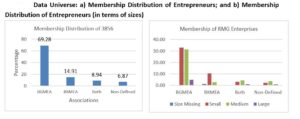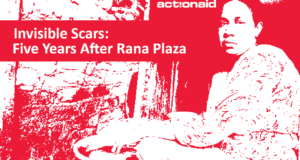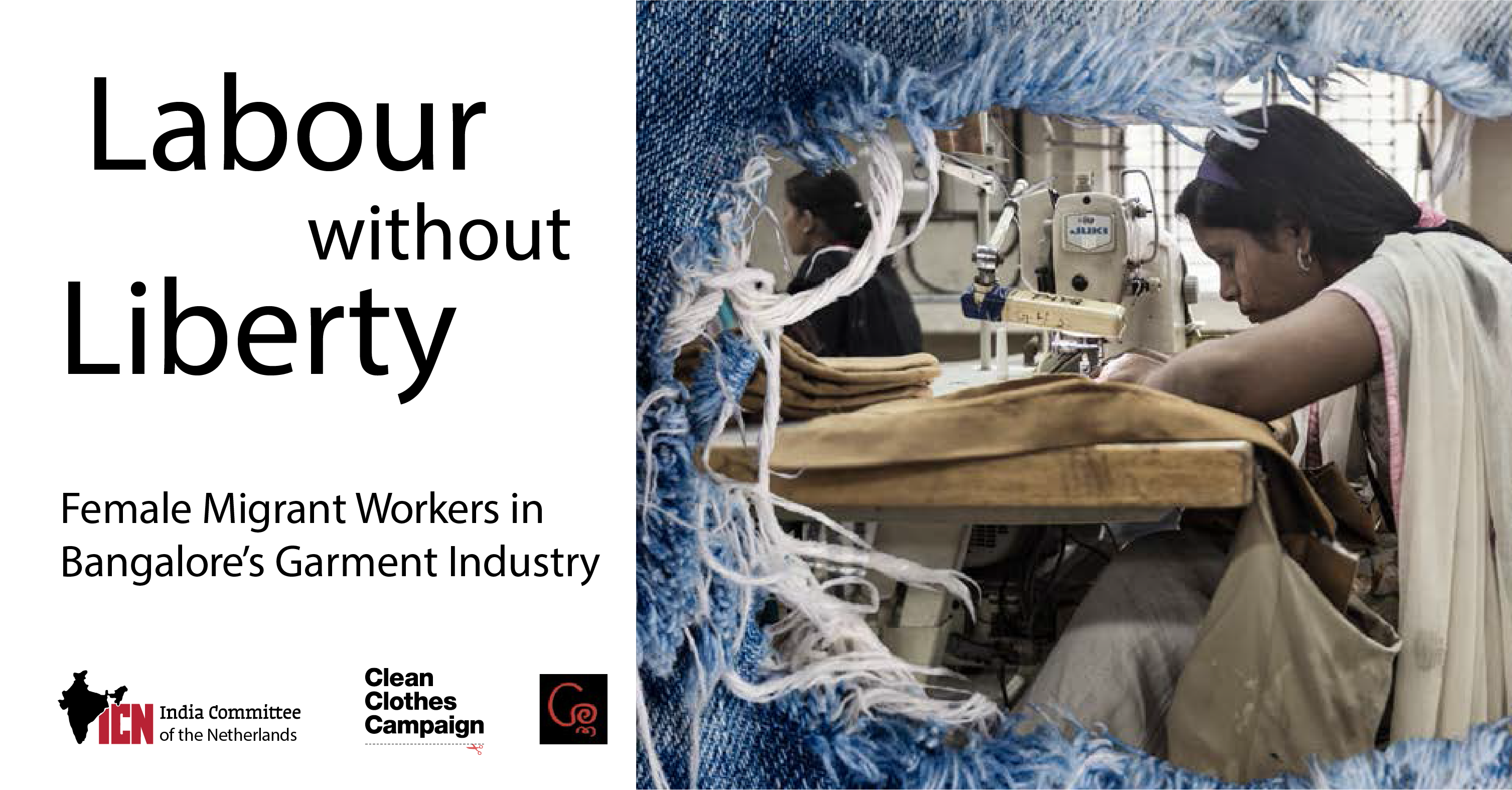Bullet points
- There are a total of 3856 factories consisting of around 3.6 million workers.
- Over 98% of total RMG enterprises are located in four districts including Dhaka (37.9%), Gazipur (28.9%), Chittagong (16.1%) and Narayanganj (14.7%)
- Reasons being better infrastructural facilities, easy availability of workers, better access to major trade routes for import and export as well as logistic and banking facilities.
- Over 98.5% of RMG enterprises are located in domestic tariff area (DTAs) and the rest 1.5% are located in EPZs.
- Of the 58 enterprises located in EPZs, majority are located in Dhaka EPZ (43.1%) followed by Chittagong and Karnaphuli EPZ (34.5%) and Adamjee EPZ (20.7%).
- The average employment in small, medium and large enterprises are 296, 1091 and 4443 workers respectively.
- BGMEA covers majority of small, medium and large enterprises. Among the members of BKMEA, medium sized enterprises are higher followed by large and small scale ones.
- The worker factory ratio is highest in Gazipur which are mostly woven product factories and they are members of BGMEA.
- The worker factory ratio is the lowest in Narayanganj which are mainly knit product factories and mainly members of BKMEA.
- 2965 factories were identified as non-operational
One of the major challenges the stakeholders of Bangladesh’s Ready-made garment sector are facing is lack of updated data. Some government and private organisations collect data but most of them are not updated on a regular basis. Lack of updated data makes it difficult for analysts to assess the sector and the future trends. A Centre for Policy Dialogue working paper carried out by CPD Research Director Dr. Khondaker Golam Moazzem and Research Associate Ms. Marzuka Ahmad Radia stresses the need of an updated ‘Data Universe’ for Bangladesh’s RMG enterprises.
“The sector needs a comprehensive database because of its overwhelming importance in the national economy in terms of industrial production, employment and export as well as its increasing demand for ensuring more accountability and transparency in the production process,” reads the paper.
The paper said that CPD RMG study has come up with a solution to this problem- a unique attempt to create a ‘data universe’ for the RMG sector of Bangladesh.
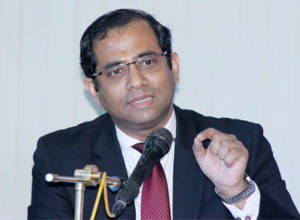
Dr. Khondaker Golam Moazzem, Research Director & Project Director, RMG Study Project
It said that based on the available data, the study has tried to create a master database of the RMG enterprises which are currently in operation. The study also offers a set of recommendations on how to develop a comprehensive database for the country.
The report said that CPD-RMG study has collected enterprise level data from seven different organisations. A total of nine datasets have been collected by CPD from different organisations and each of them has been defined separately, according to the paper.
“The initial objective is to identify unique identification number of RMG enterprises factories from all these datasets to avoid duplication in terms of identity of apparel enterprises. It pointed out that this process will help to develop a harmonized dataset of RMG enterprises,” the paper reads.
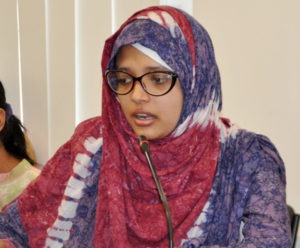
Ms Marzuka Ahmad Radia, Research Associate (Project), CPD
Data on the Garments Sector in Other Public and Private Organisations
The paper said that at present, RMG related enterprise level data is available to different public and private organisations including Department of Inspection for Factories and Establishments (DIFE), Department of Labor (DoL), Bangladesh Garments Manufacturers and Exporters Association (BGMEA), Bangladesh Knitwear Manufacturers & Exporters Association (BKMEA), the ACCORD, the ALLIANCE, and National Tripartite Action Plan for Building and Fire Safety (National Initiative).
Basic Information of the Harmonised Data
According to the paper, harmonised dataset prepared by the CPD RMG Study provides information of 6821 factories which have unique identification number. It said that since most of the dataset used for preparing the harmonized dataset do not update on a regular basis and do not keep information of factories following proper data entry method, the prepared dataset is likely to contain information of enterprises which are not in operation.
“However, the harmonized dataset could provide an overview of the enterprises of garments sector of Bangladesh. Based on this data set, a master dataset has been developed which include information on enterprises which are only in operation. This dataset has been termed as ‘Data Universe’; following sections discusses about the data universe,” the paper reads.
It said that the harmonized dataset includes information of a number of key indicators related to the apparels sector.
“This includes location of RMG enterprises including location in EPZ and domestic tariff area (DTAs), membership with different organisations and size of these enterprises. Harmonised dataset indicated that RMG enterprises are located as many as 31 different districts, however, only 4 locations are found to be significant in terms of location point of view. These include Chittagong, Dhaka, Gazipur and Narayanganj. Dhaka contains the highest number of factories. Of the 6821 factories, about 11 48 factories (about 16.8 per cent) factories have no location related information available,” the paper reads.
Data Universe of the RMG Enterprises
The paper said that CPD RMG Study team undertook a telephone call for all the enterprises of the harmonized dataset and of the 6821 enterprises, CPD team found telephone number for 6036 enterprises. “After the telephone call, it is revealed that a major revision is required in the dataset in identifying enterprises which are functionally in operation and which are ‘functionally’ not in operation. Among the reported operational enterprises, about 121 enterprises are currently ‘not in operation’. Similarly, among the reported non-operational enterprises, about 329 enterprises are found to be in ‘operation’. After necessary addition and subtraction, the CPD RMG study has identified 3856 enterprises which are functionally in operation and this enterprises constitute the Data Universe of the RMG sector of Bangladesh. The rest of the enterprises are considered to be functionally non-operational,” the paper reads.
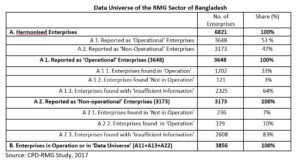
“In this backdrop, the ‘Data Universe’ include those enterprises which are currently in operation and have formal registration with public and private organisations. Please note that there is reported to be over 1000 enterprises which are not registered with any public and private organization, but have been involved in in export-oriented apparels manufacturing either partially or fully in most cases under sub-contracting arrangement. Unfortunately, information of these enterprises are not publicly available,” the paper has added.
The paper said that data universe provides key information of RMG enterprises; however, the information is rather insufficient with a view to appreciate the enterprises, their production, products, market exposure, linkages with market agents etc.
“Key information available in the data universe include enterprise’s location including those located in EPZ and outside EPZ, ownership of enterprises, types of product produced, size of employment including male and female employment and membership of enterprises,” it reads.
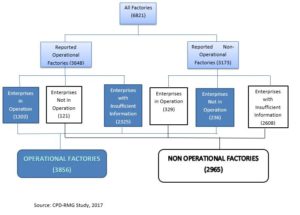
Total Population (Enterprises and Workers): According to the paper, there are a total of 3856 factories which have been identified as operational where over 36 million workers are reported to be employed. “According to the available data of workers, 53 per cent of the workers are female and 47 per cent are male.
If the factories are locationally categorized based on greater numbers of male and female workers, the distributions differ slightly from one another. Table 5 and 6 represents the locational distribution of male and female prioritized operational enterprises,” it reads.
Location of enterprises: The paper said that CPD study finds over 98 per cent of total RMG enterprises are located in four districts including Dhaka (37.9 per cent), Gazipur (28.9 per cent), Chittagong (16.1 per cent) and Narayanganj (14.7 per cent)
Most of the factories are located in different industrial clusters in these four districts particularly because of better infrastructural facilities, easy availability of workers, better access to major trade routes for import and export and logistic and banking facilities. Few factories which are located in other districts such as Mymensingh, Narshingdi, Tangail, Manikganj and Munshiganj; in most of the cases, head office of these enterprises are located in Dhaka city and nearby areas in order to do commercial and business related works.
Size of the Enterprises: The study sets a baseline of the size of the factories. Factories consisting of below 500 workers are classified as ‘small’ while ‘medium’ factories consist of 500-2500 workers. ‘Large’ factories were denoted on the basis of having more than 2500 workers. The paper said that the study found majority of the enterprises are small, which comprise about 48.9 per cent of all enterprises, followed by medium enterprises (42.5 per cent).

Only 7.4 per cent enterprises are large which accounted for 285 enterprises. Contrarily, total workers worked under different categories of enterprises is higher in medium sized enterprises (49.5 per cent) followed by large sized enterprises (small and large enterprises. “Average size of employment in RMG enterprises are quite different compared to what is observed in other major industries. The average employment in small, medium and large enterprises are 296, 1091 and 4443 workers respectively,” the paper reads.
Membership of Enterprises: The paper said that BGMEA factories comprise the lion’s share (69.2 per cent) while BKMEA factories comprise a much smaller share (14.9 per cent); besides there is another 8.9 per cent enterprises which are members of both BGMEA and BKMEA.
“Being the organization of majority of enterprises, BGMEA covers majority of small, medium and large enterprises. Among the members of BKMEA, medium sized enterprises are higher followed by large and small scale ones,” it reads.
Suggestions for Developing a Comprehensive Data Universe
According to the paper, the CPD RMG study has attempted to develop a data universe based on the available datasets. It said that given the absence of no such datasets, this data universe could partially fulfil needs of the stakeholders. The paper pointed out that the datasets have lots of limitations – most importantly, the available data do not necessarily represent the latest status of the RMG enterprises.
“At present, a number of initiatives have been undergoing to prepare database on different aspects of RMG enterprises. This includes BGMEA and BKMEA’s initiative to prepare biometric databases particularly for workers and a buyer-led initiative of GIS database of RMG enterprises. However, those attempts are likely to develop on a ‘purpose made’ mode in order to meet the need of the target group such as employers, associations and buyers. The database is a dynamic tool which requires regular updates. The CPD RMG Study plans to regularly update the existing database with the information collected from the survey and essentially develop a real-time database,” it reads.
It said that a comprehensive dataset of enterprises should target the needs of major stakeholders including government, workers, right based groups, trade unions etc. along with those of the employers and buyers etc.
“In that connection, the comprehensive datasets need to include information on enterprise level distribution of cost and return, distribution of workers under different grades, distribution of professionals, employment of foreign professionals and workers, extent of participation in backward and forward linkage parts of the value chain, distribution of margin in the value chain, types of products produced, types of machineries used, level of social compliance including workplace safety and security, level of physical compliance including fire, electrical and building safety, workers’ association including trade union and level of participation of workers, training of mid-level management and workers and compliance to environmental issues including use of ETP and industrial waste management etc,” it reads.
The paper concludes that it is expected that government, business bodies (BGMEA and BKMEA) and workers’ organisations will take a joint effort in order to prepare such comprehensive database on the RMG sector of Bangladesh.
The paper said that the comprehensive datasets need to include information on
- enterprise level distribution of cost and return
- distribution of workers under different grades
- distribution of professionals
- employment of foreign professionals and workers
- extent of participation in backward and forward linkage parts of the value chain
- distribution of margin in the value chain
- types of products produced
- types of machineries used
- level of social compliance including workplace safety and security
- level of physical compliance including fire, electrical and building safety
- workers’ association including trade union and level of participation of workers
- training of mid-level management and workers
- compliance to environmental issues including use of ETP and industrial waste management etc.
The article is based on a Centre for Policy Dialogue working paper carried out by CPD Research Director Dr. Khondaker Golam Moazzem and Research Associate Marzuka Ahmad Radia
.
 CPD RMG Study Stitching a better future for Bangladesh
CPD RMG Study Stitching a better future for Bangladesh

